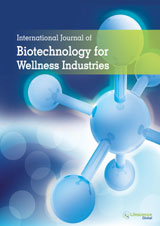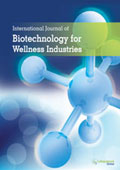ijbwi
International Journal of Biotechnology for Wellness Industries | Volume 5 Number 4
|
|
|
Circular Economy: A New Horizon for Bio-Nanocomposites from Waste Materials - Pages 121-127 Enhanced Virgin Coconut Oil (EVCO) as Natural Postmilking Teat Germicide to Control Environmental Mastitis Pathogens - Pages 128-134 Evaluation of Wines Rating Based on Sensory Characteristics Using Neural Networks - Pages 135-141 In Vitro Screening for Antimicrobial Activity of Some Medicinal Plant Seed Extracts - Pages 142-152 Management of Agroindustrial Lignocellulosic Wastes through Vermitechnology and Production of Agronomic Valid Vermicompost - Pages 153-167 |
Abstract : Antimicrobial Activity of Vigna unguiculata L. Walp Seed Oil
|
|
Abstract: The antimicrobial activity of three varieties of Vigna unguiculata L. Walp seed oil (LBS-1, LBS-2 and LBS-3) were investigated against five Gram positive bacteria (Bacillus megaterium, Bacillus subtilis, Sarcina lutea, Salmonella typhi and Staphylococcus aureus) and four Gram negative (Escherichia coli, Shigella dysenteriae, Shigella sonnei, Shigella shiga) and four fungi (Penicilium spp., Mucor spp., Candida albicans and Aspergillus fumigatius). The LBS-1 oil at the concentration of 400 μg/ disc showed the highest activity againstSarcina lutea (19±0.1 mm) than that of LBS-2 (14±0.3 mm) and LBS-3 (12±0.3 mm) oil whereas LBS-3 oil showed highest activity against Staphylococcus aureus (16±0.1 mm) than that of LBS-1 (10±0.6 mm) and LBS-2 (13±0.4 mm) oil.All the three oils are active against the three tested fungi namely Penicilium spp., Mucor spp. and Candida albicans but showed no sensitivity against Aspergillus fumigatius. Keywords: Plant oil, seed oil, Vigna unguiculata, antibacteria, antifungi.Download Full Article |
Abstract : Novel Isolates of Lactobacilli from Crop of Algerian Poultry as Potential Probiotic for Food Industry
|
|
Abstract: This study was aimed at selecting novel strains of Lactobacillus from crop of Algerian poultry. One hundred forty (140) lactobacilli strains were isolated and examined for their potentiality probiotic properties. From these isolated strains, nine appear to possess a probiotic value and highlighted a noticeable heterogeneity. The isolate L. plantarum G1 showed the best inhibitory activity against several indicator strains. Furthermore, the results showed that culture and neutralized supernatants exhibited varying degrees of inhibitory activity against strains of enterobacteria from poultry origin. The tested strains were acid resistant and were also bile tolerant. Antibiotic resistance, co-aggregation activity and hydrophobicity percentage were strain-dependent. Moreover, six strains were able to adhere to epithelial cells. Finally, six Lactobacillus strains, such as strain L. plantarum G1, L. plantarum PC2, L. viridesencs G3, L. helveticus PC6, L. delbrueckii ssp delbrueckii G7 and L. fermentum PC8, showed essential probiotic properties. The identity of the best strain L. plantarum G1 was confirmed by 16S rRNA gene sequence using PCR. Keywords: Lactobacillus, Poultry crop, Probiotic properties, Adhesion.Download Full Article |
Abstract : Bioactive Natural Products from Plants and Biotechnological Approaches for their Production
|
|
Abstract: Bioactive natural products are economically important as drugs, fragrances, pigments, food additives and pesticides. The biotechnological tools are important to select, multiply, improve and analyze medicinal plants for production of such products. The utilization of medicinal plant cells for the production of natural or recombinant compounds of commercial interest has gained increasing attention over the past decades. Plant tissue culture systems are possible source of valuable medicinal compounds, fragrances and colorants, which cannot be produced by microbial cells or chemical synthesis. In vitro production of bioactive natural products in plant cell suspension culture has been reported from various medicinal plants and bioreactors are the key step towards commercial production. Genetic transformation is a powerful tool for enhancing the productivity of novel products; especially by Agrobacterium tumefacians. Combinatorial biosynthesis is another approach in the generation of novel natural products and for the production of rare and expensive natural products. Recent advances in the molecular biology, enzymology and bioreactor technology of plant cell culture suggest that these systems may become a viable source of important secondary metabolites. Genetic fingerprinting could be a powerful tool in the field of medicinal plants to be used for correct germplasm identification. In addition, when linked to emerging tools such as metabolomics and proteomics, providing fingerprints of the plant’s metabolites or protein composition, it gives data on phenotypic variation, caused by growth conditions or environmental factors, and also yield data on the genes involved in the biosynthesis. DNA profiling techniques like DNA microarrays serve as suitable high throughput tools for the simultaneous analysis of multiple genes and analysis of gene expression that becomes necessary for providing clues about regulatory mechanisms, biochemical pathways and broader cellular functions. New and powerful tools in functional genomics can be used in combination with metabolomics to elucidate biosynthetic pathways of natural products. Keywords: Natural Products, Biosynthetic Pathway, Cell Culture, RNAi, Transcriptomics.Download Full Article |
























